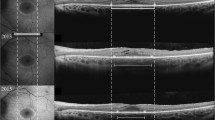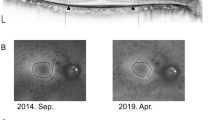Abstract
Purpose
To evaluate the progression of retinitis pigmentosa (RP) due to mutations in rhodopsin (RHO) by measuring the short-wavelength autofluorescence (SW-AF) increased autofluorescence ring and ellipsoid zone (EZ)-line width.
Methods
Fundus autofluorescence (FAF) and spectral domain optical coherence tomography (SD-OCT) images were obtained from 10 patients with autosomal dominant RP due to mutations in the RHO gene. Measurements of ring area on FAF images, as well as the EZ line width on SD-OCT images and horizontal, vertical diameter, were performed by two independent masked graders.
Results
The ring area decreased by a rate of 0.6 ± 0.2 mm2 per year. We observed that the EZ line width decreased by an average of 152 ± 37 μm per year, while the horizontal and vertical diameters decreased by 106 ± 35 μm and 125 ± 29 μm per year, respectively. Progression rates were similar between eyes.
Conclusions
We observed SW-AF ring constriction and a progressive loss of EZ line width over time.


Similar content being viewed by others
References
Boughman JA, Conneally PM, Nance WE (1980) Population genetic studies of retinitis pigmentosa. Am J Hum Genet 32:223–235
Hartong DT, Berson EL, Dryja TP (2006) Retinitis pigmentosa. Lancet 368:1795–1809. https://doi.org/10.1016/S0140-6736(06)69740-7
Sullivan LS, Bowne SJ, Birch DG et al (2006) Prevalence of disease-causing mutations in families with autosomal dominant retinitis pigmentosa: a screen of known genes in 200 families. Investig Ophthalmol Vis Sci. https://doi.org/10.1167/iovs.05-1443
Tsang SH (2006) GAP-independent termination of photoreceptor light response by excess subunit of the cGMP-phosphodiesterase. J Neurosci. https://doi.org/10.1523/JNEUROSCI.4775-05.2006
Woodruff ML, Janisch KM, Peshenko IV et al (2008) Modulation of phosphodiesterase6 turnoff during background illumination in mouse rod photoreceptors. J Neurosci. https://doi.org/10.1523/JNEUROSCI.2973-07.2008
Janz JM, Fay JF, Farrens DL (2003) Stability of dark state rhodopsin is mediated by a conserved ion pair in intradiscal loop E-2. J Biol Chem. https://doi.org/10.1074/jbc.M210567200
Yan ECY, Kazmi MA, Ganim Z et al (2003) Retinal counterion switch in the photoactivation of the G protein-coupled receptor rhodopsin. Proc Natl Acad Sci. https://doi.org/10.1073/pnas.1531970100
Tsang SH, Burns ME, Calvert PD et al (1998) Role for the target enzyme in deactivation of photoreceptor G protein in vivo. Science (80- ). https://doi.org/10.1126/science.282.5386.117
Woodruff ML, Wang Z, Chung HY et al (2003) Spontaneous activity of opsin apoprotein is a cause of Leber congenital amaurosis. Nat Genet. https://doi.org/10.1038/ng1246
Lisman J, Fain G (1995) Support for the equivalent light hypothesis for RP. Nat Med 1:1254–1255. https://doi.org/10.1038/nm1295-1254
Comerford MB, Besterman EM (1976) An eighteen months’ study of the clinical response to metoprolol, a selective beta1-receptor blocking agent, in patients with angina pectoris. Postgrad Med J 52:481–486
Sancho-Pelluz J, Tosi J, Hsu C-W et al (2012) Mice with a D190N mutation in the gene encoding rhodopsin: a model for human autosomal-dominant retinitis pigmentosa. Mol Med. https://doi.org/10.2119/molmed.2011.00475
Lima LH, Cella W, Greenstein VC et al (2009) Structural assessment of hyperautofluorescent ring in patients with retinitis pigmentosa. Retina 29:1025–1031. https://doi.org/10.1097/IAE.0b013e3181ac2418
Robson AG, Saihan Z, Jenkins SA et al (2006) Functional characterisation and serial imaging of abnormal fundus autofluorescence in patients with retinitis pigmentosa and normal visual acuity. Br J Ophthalmol. https://doi.org/10.1136/bjo.2005.082487
Robson AG, Lenassi E, Saihan Z et al (2012) Comparison of fundus autofluorescence with photopic and scotopic fine matrix mapping in patients with retinitis pigmentosa: 4- to 8-year follow-up. Investig Opthalmol Vis Sci 53:6187. https://doi.org/10.1167/iovs.12-10195
Robson AG, Tufail A, Fitzke F et al (2011) Serial imaging and structure-function correlates of high-density rings of fundus autofluorescence in retinitis pigmentosa. Retina. https://doi.org/10.1097/IAE.0b013e318206d155
Aizawa S, Mitamura Y, Hagiwara A et al (2010) Changes of fundus autofluorescence, photoreceptor inner and outer segment junction line, and visual function in patients with retinitis pigmentosa. Clin Exp Ophthalmol 38:597–604. https://doi.org/10.1111/j.1442-9071.2010.02321.x
Wakabayashi T, Sawa M, Gomi F, Tsujikawa M (2010) Correlation of fundus autofluorescence with photoreceptor morphology and functional changes in eyes with retinitis pigmentosa. Acta Ophthalmol 88:e177–e183. https://doi.org/10.1111/j.1755-3768.2010.01926.x
Lima LH, Burke T, Greenstein VC et al (2012) Progressive constriction of the hyperautofluorescent ring in retinitis pigmentosa. Am J Ophthalmol 153:718–727.e2. https://doi.org/10.1016/j.ajo.2011.08.043
Kremmer S (1997) Ocular findings in patients with autosomal dominant retinitis pigmentosa and Cys110Phe, Arg135Gly, and Gln344stop mutations of rhodopsin. Graefes Arch Clin Exp Ophthalmol. https://doi.org/10.1007/BF00947087
Sujirakul T, Lin MK, Duong J et al (2015) Multimodal imaging of central retinal disease progression in a 2-year mean follow-up of retinitis pigmentosa. Am J Ophthalmol 160:786–98 e4. https://doi.org/10.1016/j.ajo.2015.06.032
Cabral T, Sengillo JD, Duong JK et al (2017) Retrospective analysis of structural disease progression in retinitis pigmentosa utilizing multimodal imaging. Sci Rep 7:10347. https://doi.org/10.1038/s41598-017-10473-0
Hamel C (2006) Retinitis pigmentosa. Orphanet J Rare Dis 1:40. https://doi.org/10.1186/1750-1172-1-40
Cai CX, Locke KG, Ramachandran R et al (2014) A comparison of progressive loss of the ellipsoid zone (EZ) band in autosomal dominant and X-linked retinitis pigmentosa. Investig Ophthalmol Vis Sci 55:7417–7422. https://doi.org/10.1167/iovs.14-15013
Tsai Y-T, Wu W-H, Lee T-T et al (2018) Clustered regularly interspaced short palindromic repeats-based genome surgery for the treatment of autosomal dominant retinitis pigmentosa. Ophthalmology. https://doi.org/10.1016/j.ophtha.2018.04.001
Rossmiller BP, Ryals RC, Lewin AS (2015) Gene therapy to rescue retinal degeneration caused by mutations in rhodopsin. Methods Mol Biol 1271:391–410. https://doi.org/10.1007/978-1-4939-2330-4_25
Latella MC, Di Salvo MT, Cocchiarella F et al (2016) In vivo editing of the human mutant rhodopsin gene by electroporation of plasmid-based CRISPR/Cas9 in the mouse retina. Mol Ther - Nucleic Acids. https://doi.org/10.1038/mtna.2016.92
Mao H, Gorbatyuk MS, Rossmiller B et al (2012) Long-term rescue of retinal structure and function by rhodopsin RNA replacement with a single adeno-associated viral vector in P23H RHO transgenic mice. Hum Gene Ther. https://doi.org/10.1089/hum.2011.213
Bassuk AG, Zheng A, Li Y et al (2016) Precision medicine: genetic repair of retinitis pigmentosa in patient-derived stem cells. Sci Rep. https://doi.org/10.1038/srep19969
Sujirakul T, Davis R, Erol D et al (2015) Bilateral concordance of the fundus hyperautofluorescent ring in typical retinitis pigmentosa patients. Ophthalmic Genet. https://doi.org/10.3109/13816810.2013.841962
Iriyama A, Yanagi Y (2012) Fundus autofluorescence and retinal structure as determined by spectral domain optical coherence tomography, and retinal function in retinitis pigmentosa. Graefes Arch Clin Exp Ophthalmol. https://doi.org/10.1007/s00417-011-1823-5
Funding
The Jonas Children’s Vision Care and Bernard & Shirlee Brown Glaucoma Laboratory are supported by the National Institutes of Health [P30EY019007, R01EY018213, R01EY024698, R01EY026682, R21AG050437], National Cancer Institute Core [5P30CA013696], Foundation Fighting Blindness [TA-NMT-0116-0692-COLU], the Research to Prevent Blindness (RPB) Physician-Scientist Award, and unrestricted funds from RPB, New York, NY, USA. S.H.T. is a member of the RD-CURE Consortium and is supported by ARVO/Genentech, Kobi and Nancy Karp, the Crowley Family Fund, the Rosenbaum Family Foundation, the Tistou and Charlotte Kerstan Foundation, the Schneeweiss Stem Cell Fund, New York State [C029572], and the Gebroe Family Foundation.
Author information
Authors and Affiliations
Corresponding author
Ethics declarations
All procedures performed in studies involving human participants were in accordance with the ethical standards of the institutional and/or national research committee and with the 1964 Helsinki declaration and its later amendments or comparable ethical standards.
Conflict of interest
The authors declare that they have no conflict of interest.
Additional information
Publisher’s note
Springer Nature remains neutral with regard to jurisdictional claims in published maps and institutional affiliations.
Electronic supplementary material
ESM 1
(DOCX 19 kb)
Rights and permissions
About this article
Cite this article
Takahashi, V.K.L., Takiuti, J.T., Carvalho-Jr, J.R.L. et al. Fundus autofluorescence and ellipsoid zone (EZ) line width can be an outcome measurement in RHO-associated autosomal dominant retinitis pigmentosa. Graefes Arch Clin Exp Ophthalmol 257, 725–731 (2019). https://doi.org/10.1007/s00417-018-04234-6
Received:
Revised:
Accepted:
Published:
Issue Date:
DOI: https://doi.org/10.1007/s00417-018-04234-6




